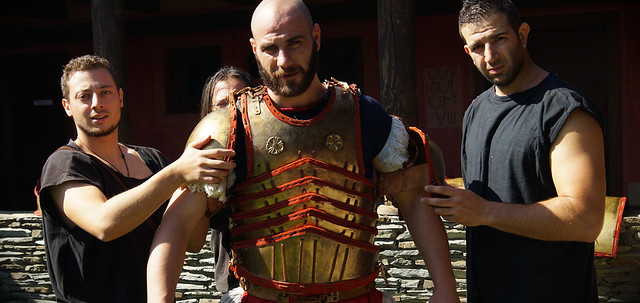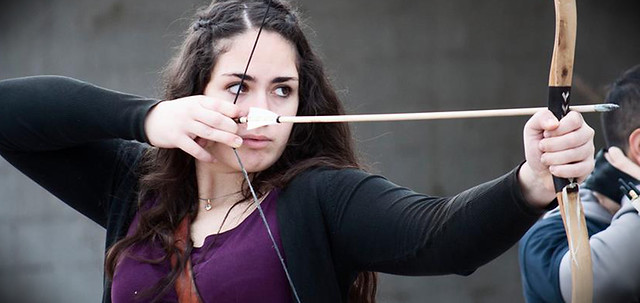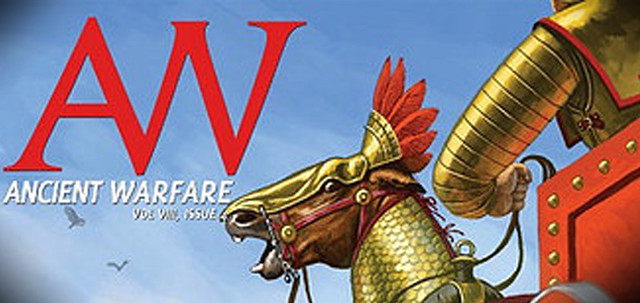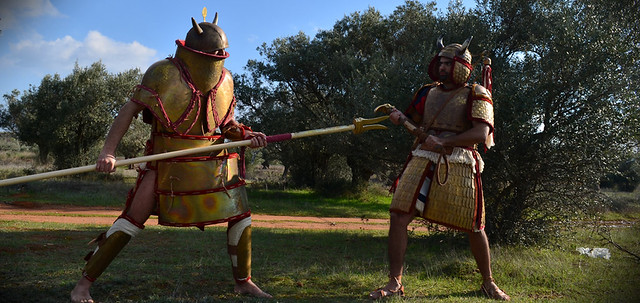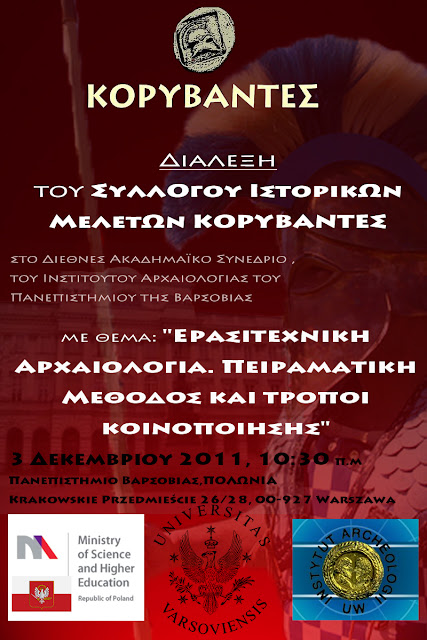The Living History Association "KORYVANTES", had the special honor to be invited by the Institute of Archaeology of the University of Warsaw, to participate in the International Conference Archaeology with the subject: "Archaeological Heritage-Methods of Education and Popularization", 1st to 5th December 2011.
The Assoaciation participated with a (December 3, 2011, 10: 30 a.m.) on the subject of Ammature Experimental Archaeology and popularization methods (Amateurs and Archeology. Experimental method or madness. How do we Share it all?) .
The President of the Association Mr. Spyridon Bakas, Political Scientist successfully presented the profile and the activities of our Association, forms of experimental archaeology, the difficulties of implementing living history in the modern Greek environment and ways of transmitting the results of experimental Archaeology through channels that Conventional Archaeology cannot approach.
Photo : President of Association "KORYVANTES", Spyridon Bakas, in the Warsaw University
Below there is a small passage of our lecture as the full text of our study will be soon uploaded on our website ( www.koryvantes.org )
-------------------------------------------------------
The exploitation of the Ancient Greek Hoplite’s image had started from the beginnings of the 19th century, through the Romantic novelists who wanted for reasons of historical propaganda to use prototypes from the past. The reenacting of Ancient Greek Hoplites started in the UK during the 80s and the 90s based on Anglo-Saxon prototypes of images and studies as those were promoted by works popular history publications.
The first of these romantic efforts had limited effect but fertilized the idea of similar attempts around the world. With slow steps Hoplite Reenacting appeared in Greece in the late 90's to clear native problems of existence, since the means and the quality were too low. These problems were:
A) We had to express our work in the conservative to the new and groundbreaking cultural events social landscape of modern Greece Besides all the obvious obstacles confronted with stereotypes that dominated in Greece for decades by the use of the image of the soldier for propaganda purposes by the governments of the past. The image thus, the Greek soldier was already formed in the mind of the modern Greek as something suspicious as something estranged, something fanatic.
B) In addition our Association had been confronted with stereotypes in historical research like those mentioned above. More specific, Ancient Greek Warfare had been studied extensively in the past but not very adequately by Western scholars in recent decades. These studies have not been able to come in an efficient manner the above issues and lacked an experiment.
C) Another difficulty that we had to face was being invited to "bring life" a period of history and tradition that had been cut off for at least 2000 years. In contrast to the Medieval reenacting for example, already known widespread in Europe, it had this problem since the medieval tradition in one way or another has never disappeared from the European peoples. Closing then, the time gap, and the quest for the lost knowledge of the ancient greek warfare was a big challenge for us.
EXPERIMENTAL ARCHAEOLOGY
We could define Experimental Archaeology as the process during which, and through the application of appropriate conditions, we attempt a scientifically documented historical reconstruction with the aim to draw scientific conclusions in questions that traditional history or archaeology cannot answer. So Experimental Archaeology steps in to fill the gaps, complete the lines and clear the filed in dark areas of historical research
Our club has conducted various experimental archeology projects that deal with both the reconstruction of hybrid ancient weapons, but also with the test / examination practices combat conditions of Ancient Greek hoplite Phalanx.
An example of experimental archeology project and milestone in our research was the reconstruction Linothorax. Linothorax is that cloth, armor, built on the linen cloth, which was dominant armor in Greece from the 7th until the 3rd century B.C. During the year 2010 collaborated with the distinguished scholar / armorer Dimitris Katsikis (Retains permanent exhibitions in Dumbarton Oaks research center Harvard trustees USA) in order to construct realistically the first historically correct linothorax. The main objective was, through a process of experimental archeology and scientific documentation to reconstruct the Standard Linothorax with utmost historical accuracy.
The effort to which we refer was inherently difficult because Linothorax disappeared at the end of the Hellenistic era - Roman equipment was dominant - and we have little information on the actual process of construction. Previous attempts to build our Linothorax were based on artistic and technical / technological stereotypes that haunted the image of an ancient Greek soldier in the last century. We believe the misconceptions that we have about what the image and the construction methods of the ancient hoplite’s linothorax were, are due to the fact that authors of these stereotypes were people with no real knowledge of what the phalanx really was and how protection operates in these specific combat conditions. While the image of the soldier in white linothorax and rigid attitudes based on sophisticated shots of soldiers and of course in painting techniques to blood vessels, bares little relation to reality.
We experimented with these stereotypes, but through experimentation we noticed the futility of this effort. Here comes the value of experimental archeology, which directly illustrates and demonstrates the faults of the commonly accepted views. With the use of 8 basic directions first started constructing linothorax. These 8 points are:
Use historical sources and archaeological evidence for the reconstruction duplicates the hardware era under investigation.
- Practical application of the item in research to the appropriate physical environment and conditions of the era under examination (testing the linothorax in temperatures between 35 40 centigrade during the Greek summer)
-Adapting to the psychology of the peoples and cultures of the era under research. (Testing a linothorax in continuous use, through combat conditions, despite the hardships.)
-Ability to use later or modern information as complement to bridge historical gaps. Historical ancient sources on how to build a Linothorax do not exist, but Byzantine authors give valuable information about similar armors.
-The Hoplite needed flexible armor in order to be able to move his body effectively in the stifling conditions of two colliding phallanxes composed of heavy infantry. (othismos) The armor must allow freedom of movement in all dimensions. At anytime the fighter may have to crouch to run, kick, to use in all directions weapons construction and repair is possible to do using household tools and materials laboratories or simple campaign segmental construction and easy repair and / or reuse parts.
-Proper function with other pieces of equipment (shield, helmet, spear, sword, knives).A finding that we had from our initial experiments is that any protective device must be designed as part of the shield system, which is quite logical as the whole hoplite phalanx battle was based on the use of the shield.
-Combination of materials with different mechanical properties and putting them in the places needed should be designed as a weapon of war and not as an exhibit tables
- Importance of protecting the exposed torso not just weapons but plucked from thrusting heavy blows. Required below the shield to any ypachei a layer that absorbs the energy of thrusting hits
-The result proved us right. The publication of our study in military magazines was a milestone in the investigation of Ancient Greek Armor, experimental archeology worldwide, taking the credit specialists.
THE POPULARIZATION OF EXPERIMENTAL ARCHAEOLOGY
The conventional Archaeology through research methods that have been established comes to promote historical knowledge and to discover new horizons istorias. Iimparting knowledge, the transmission conclusions promoted through conventional channels of communication such as writing books, conferences, transmits knowledge through University Education. The welcome and legitimate this statement lacks perhaps the result of an efficient communication and modern way of communicating and sharing knowledge of new methods of intensification of externalization. Many times even the modernization efforts of knowledge transfer and marginalized succumb narrowly standards. For example a study or scientific work history / archeology can give the public an image of what it describes, resorting to the solution of computer graphics (drawing). This may be an ambitious and respected effort, can not be sure but 100% correct history of the project,-a cartoonist and forms a tangible vision of what painting - while not able to ensure the successful acceptance of from the receiver (public, readers), because it is a one-dimensional stereoscopic imaging and single.
Alongside so many forms of social activity, not only as music, sport, the life style, the printed and electronic press unable be accessed by conventional Archaeology precisely because of this one-dimensional operation. A large part of social life remains outside the realm of archeology, and we get to know the wealth of this knowledge. Experimental Archaeology is a complex process of linking people and organizations, utilize skills and resources, to create a cultural product.
The experimental archeology through its capacity to move to non-traditional avenues of research may be capable of transmitting this knowledge with respective Alternative ways. Our Club over the years through diverse activities and interactive participations has managed to find new ways of communication, new channels in which results of experimental archeology can be accepted by the public with maximum effectiveness. We, Koryvantes, perceive Experimental Archaeology as the most efficient process to link Archaeology with specific Social activities, providing real value in supporting historical accuracy and promote the work of the Archaeologist. We created something new, a peculiar intellectual property and managed to promote a diversity of channels, where the message of the conventional Archaeology had not heard before.
The power of "multidimensional"
Arguably the portrayal of a stereoscopic image (drawing) enlivens the historical study on the subjective measure that may be made the subject of acceptance by the receiver. Sketches were an ideal model for the research in the 70s, 80s, and 90s but not for today. The deal for our Association was how we transform something from no-dimensional to multidimensional. The point is how the material is being formed in three dimensions so that the receiver knows that what you read in the text can actually be tested, reconstructed, and be a vival proof that the living history verifies the theory. Furthermore the three-dimensional denaturing theory now becomes practical subject, makes the viewer more effectively embrace the theory, to accept and getting close to the archeology that now is not something impersonal. The monotonous paragraphs of a study of ancient writings, become a living being, which can be touch hear, feel, understand better.
In this context our club has managed to publish our own studies and articles on monthly basis in Greek special press and on our internet site. Also specialty magazines in Greece use our photos for their Ancient Greek topics on monthly basis. We have also started collaboration with a Famous International Press Organization to start using our photos in their future publications. Finally we are proud that our work was presented in lifestyle magazines, as pieces of modern art.
"The power of interactive participation"
Without doubt Experimental Archeology has indisputable advantages when used as an interactive medium with participation of the public. The living history and the rebirth of the past efforts when combined with the parallel participation of the public may produce great appreciation results. Modern presentation methods use the interactive communication activities as an effective understanding of the message from the receiver. There are many examples of museums, reports that the viewer can "participate" in the presentation through prototype methods and actions. Our club had the opportunity to implement such activities notification of experimental archeology with interactive applications in the recent Festival of Archaeological Biskupin Poland (17 to 25 September
2011). Products of experimental archeology, such as a technical movement, a hoplite Phalanx drill , a Phalanx Formation were combined in a harmonious manner with the public participation of small children in the event. The result of the interaction between the receiver and the transmitter, through two-way interactive interaction was very succesfull. The use of many human senses (touch, hearing, vision, smell) and simultaneous participation of a receiving audience in the presentation is an effective guarantee for the acceptance of Experimental Archeology results.In this context our Association has managed to participate in various public activities such as demonstrations and lectures to young students, public presentations in cultural events and speeches to the public about the Ancient Greek Martial Arts
------------------------
The full text of our study will be uploaded on our website: www.koryvantes.org
------------------------
The full text of our study will be uploaded on our website: www.koryvantes.org
